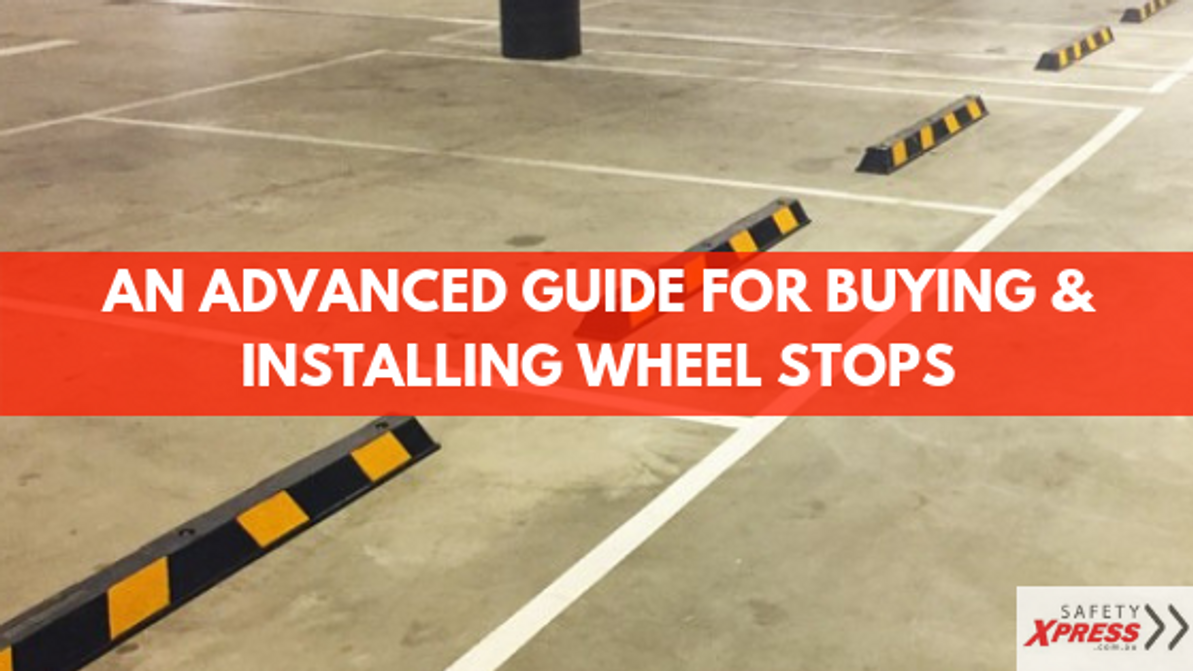An Advanced Guide for Buying & Installing Wheel Stops

We at Safety Xpress are a leading supplier of safety products in Australia. With years of experience, we understand what businesses need to run their operations safely. That’s why we stock, supply, and now even help you install the best safety products in your workshop, factory, warehouse, storefront, parking complex or anywhere else.
Adding Safety With Wheel Stops
Wheel
stops are one of the best tools for controlling and managing high vehicle traffic. You can avoid
collisions and unnecessary damage to a vehicle by using the right
Wheel Stops. They are designed
to add more safety to your storefront or parking complex.
If you talk about the aesthetic appeal- wheel stops definitely can add that too with their sleek and discreet design styles.
So, if you have to buy and install wheel stops on your premises – this blog is for you.
Getting Started With Wheel Stops
There are different types of wheel stops like Rubber Wheel Stops and Polyethylene Wheel Stops.
Rubber Wheel Stops are made of a strong recycled material and have reflective epoxy yellow panels. They are highly suitable for factories, warehouses and parking complexes.
On the other hand, Polyethylene Wheel Stops are made of a type of plastic known for its strength and durability. They come with great longevity and a clean professional look.
You will find both these wheel stops on our website. Here are some more features of SafetyXpress’ Wheel Stops:
- Come with reflective markings for high visibility, even during nights
- Oil and heat resistant
- Solid built and weatherproof
- Do not fade in the sun
- Each one comes with a manufacturer’s warranty
- Easy to install yourself or you can get assistance from our recommended installers – Durasafe.
However, if you are still confused about which Wheel Stop you should buy - here’s some help:
#1 Identify the space where you want to install the wheel stops.
Where are you planning to place them? Is it a commercial, industrial or a residential area? The wheel stops must be selected depending on the area.
#2 What kind of vehicles do you expect on your premises?
Identify what kind of vehicles will be using the wheel stops. wheel stops designed especially for cars and we also have wheel stops that can take a hit from a heavy vehicle like a truck.
#3 Estimate the volume of traffic you get.
You may have a clear idea about the traffic volume of the place where you are planning to install the wheel stops. We have wheel stops with varying thickness levels which are adaptable for heavy or light traffic flow.
#4 Other Factors
Do you need wheel stops compliant for your disabled parking bays? Then you should choose our Rubber Wheel Stop - Disabled BLUE as they come with BLUE Reflective epoxy panels on their faces.
Once you figure out the most-suited wheel stop for your purpose, place an order with us on our website. We can arrange same day dispatch for you if you order before noon. Did we mention that we deliver Australia wide?
Next Up – Wheel Stops Installation
Now moving to your second concern - the installation of wheel stops.
You will no doubt receive the wheel stops from us on time and the next step will be installing them safely.
We can provide you with the required fixings for installation. You can do it yourself with the help of your friends or colleagues. If you don’t have time for that- we would recommend calling Durasafe and getting your wheel stops installed safely.
They are our trusted safety partners and a leading installer for all kinds of safetyproducts in Australia.
But if you do decide to install them yourself, here are step-by-step installation instructions for wheel stops. You can use these common instructions for all kinds of wheel stops. Take a look!
DIY Installation Guide for Wheel Stops
#1 Rubber or Polyethylene Wheel Stops for Concrete Surfaces
What Will You Need?
- A hammer drill with a 14mm masonry drill bit
- The M10 screw fixings (comes with the supplied wheel stops)
- A 17mm socket
- A hammer
- An industrial vacuum or a hand broom (this is optional)
How Will You Install Them?
- 1.Spot the exact place of installation and put the wheel stop over it.
- 2.Using a hammer drill, drill a guide hole in the concrete through each hole in the wheel stop with the help of a 14mm masonry drill bit.
- 3.Remove the wheel stop and clean the space with your industrial vacuum or a simple hand broom.
- 4.Continue to drill each guide hole to a depth of approximately 120mmand repeat the cleaning process.
- 5.Put the plastic plug component of the fixing in the drilled hole and hammer in.
- 6.Now, place the wheel stops over the holes while lining them up.
- 7.Place the supplied M10 screw through the wheel stop and into the plastic plug.
- 8.Tighten the M10 screw with the help of 17mm socket.
- 2.Rubber or Polyethylene Wheel Stops for Asphalt/Gravel Surfaces
What Will You Need?
- A hammer drill with a 14mm masonry drill bit
- The road spikes (supplied with the wheel stops)
- A hammer
- An industrial vacuum or a hand broom (optional)
How Will You Install Them?
- 1.Identify the exact place where you want to place your wheel stop.
- 2.Place the wheel stop and drill a guide hole with the 14mm masonry drill bit.
- 3.Remove the wheel stop and if required, vacuum away the dust.
- 4.Continue to drill each guide hole up to an approximated depth of 120mm.
- 5.Place the wheel stops over the hole and line them up.
- 6.Hammer the supplied road spikes through the wheel stop and into the road surface.
If you are not confident of installing wheel stops or not willing to have the hassle – just call a professional to do the job.
We recommend Durasafe - the professional team who has the extensive knowledge, experience and expertise to carry out all types of installation work. The distance from kerbs, walls and drains differ according to the locations. This may further confuse you on where to place the wheel stops.
They will come on site with all the tools and gadgets to accurately install your wheel stops within no time. You can send an enquiry through their website www.durasafe.com.au or by calling them on 1300 049 246.
Recent Posts
-
Which Speed Hump For Which Location?
At Safety Xpress, we have 3 types of Australian compliant speed humps. All of which suit different …16th Jul 2021 -
4 Useful Applications of Handrail Systems
Handrails are a key feature of many buildings. Also known as safety railing, handrails preve …15th Jan 2019 -
Strong & Durable Handrails That Don’t Need Any Welding
Staircases, walkways, pool decks, balconies - railings are found everywhere. Imagine a proper …8th Jan 2019




